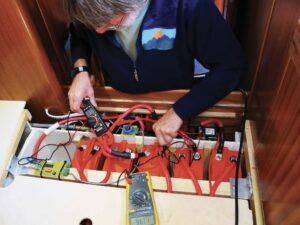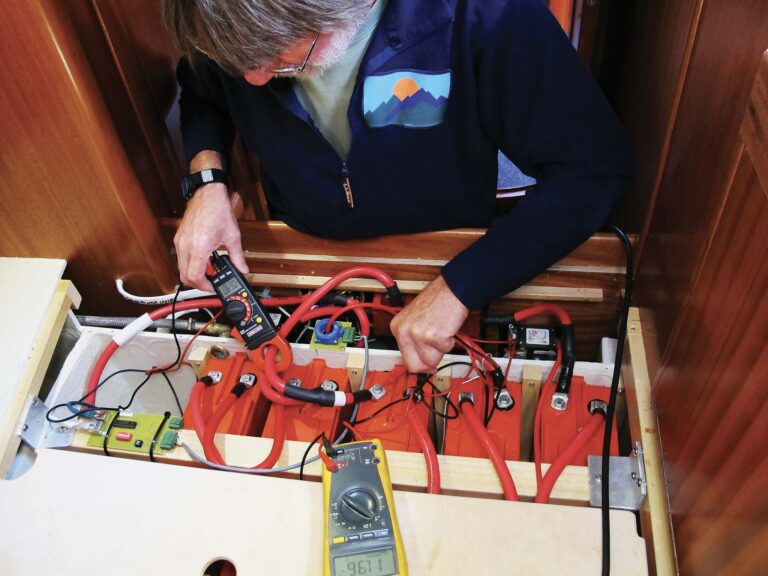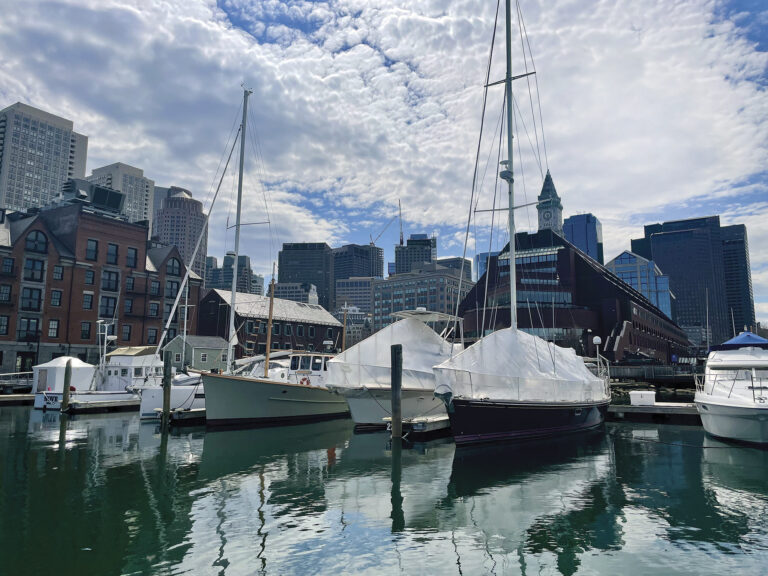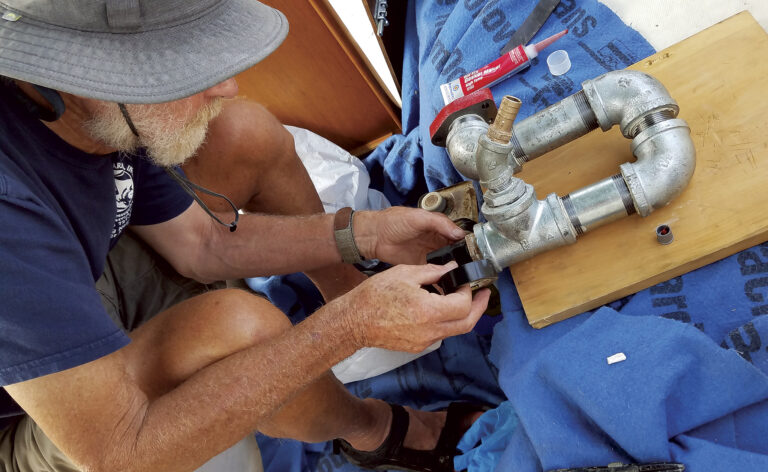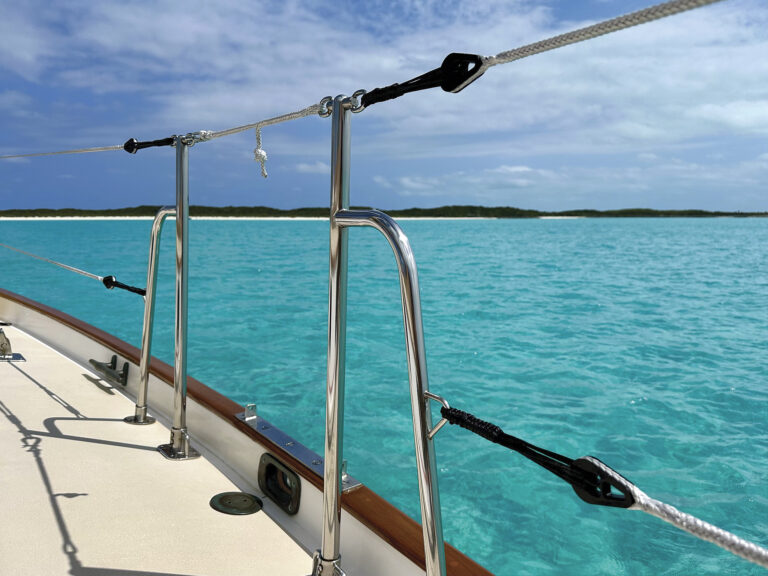
Your ground tackle is like a relationship—the more you care for it, the longer it will last. So, how do you enhance the relationship? First up, think of the accommodations—a damp, salt-rich, often warm environment, just the kind of thing to encourage corrosion. What can be done?
Looking at chain lockers, I marvel at how inappropriate some are. I’ve seen lockers on yachts with drain holes so high it’s inevitable the “bottom” of the locker and its contents—the expensive chain—will constantly be underwater. If you never deploy all your chain you would simply not know that you have the perfect location to ensure its life is minimized. Devoid of attention, the chain at the bottom of such lockers will quickly corrode into one rusty lump. And it’s not only the submerged chain that will corrode. Seawater will also wick up through the links and any heat will cause evaporation, creating vapor that will condense to provide fresh electrolyte allowing your entire chain to quietly rust.
So, what’s a sailor to do? There are a number of options. The obvious one is to install new drain holes at the bottom of the locker, unless it is below, or very close to the waterline. New drain holes should be drilled (with considerable care) “upward” from below the base of the locker and from aft forward. This will ensure the water drains down and aft. Ideally, you should cover the exterior of the drain holes with a clamshell vent, available from most chandlers. Remember that whatever you are drilling through, it will need to be properly sealed with epoxy and gelcoat, whether it’s solid glass, foam-cored or wood.
After that, be sure to keep your locker drain holes clear. I know of one yacht where the locker filled with seawater on a long windward passage when the drain hole was blocked with a teabag. Similarly, the drain holes in one multihull’s anchor locker were blocked with the ends of fender ropes, causing the entire locker to fill with water, probably about a ton of it.
If you don’t want to drill holes in your bow, an alternative is to lift the locker base to just above the existing drain holes—though this will obviously reduce locker volume and still leave you with a puddle (unless you completely seal off the lower section of the locker).

While you’re at it, add a perforated base so your chain can sit and drain freely. Note: these perforated panels need to be quite strong if you carry a lot of chain and can be made from offcuts of fiberglass that can be sourced quite easily. There are also a number of suppliers of perforated fiberglass grating panels that look to be identical in design and are load bearing from companies like North American Grating, National Grating and Versagrate.
An equally good alternative is plastic perforated marine decking, like that made by ThruFlow (based in Canada, but with distributors in the U.S.). All are load-bearing and could easily be modified as a locker base. Be aware, though, that these commercial products are sometimes sold in quite large volumes, and you might need to find a local installer from whom you can source an offcut. Shop around. Some of this grating is sold in the form of 4×4 rescue “bridges” or sold retail in smaller sizes. Cheaper and less robust options might also be had at a hardware store, or you could just chop up an old milk crate.
The chain locker on my catamaran is part of the boat’s bridge deck. It has a flat, gently sloping base, which we have lined with rubber floor mats. These are perforated and have a raised, dimpled base that allows water to drain and also lets air circulate.
KEEP IT CLEAN
I would highly recommend that your chain locker is regularly hosed down with fresh water, to remove salt and mud. Whenever possible, we leave our locker hatch open to let the rain to wash things out. Having the chain locker open after the weather improves also allows the chain to dry out again.
Mud, in particular, can be a killer for chain. Many sea muds host various different anaerobic organisms that secrete sulfur-based compounds, which then convert to sulphuric acid. (You can sometimes smell them.) Sulfuric acid, of course, is the death knell for galvanizing. You can tell if you have anchored in one of these muds if your chain, even when clean, is black, as opposed to silver or gray. I’ve even seen unconfirmed, anecdotal reports of galvanizing being stripped off overnight in some situations, although this seems most unlikely as it takes a strong acid to strip and clean galvanizing from steel. Still, there may be a grain of truth to it given the quality of some galvanizing.

WINDLASS LOVE
Next time you look into your locker, check out the layout of your windlass. The electric motor should be as far away from the fall of the chain as possible. Most modern windlasses can be installed with the motor in a number of different positions, and sometimes, because it’s easy, the installer might have located the motor under or near the fall of the chain. (Don’t ask how I know!) Chain, of course, carries seawater when it is retrieved, and if the fall of the chain is near the windlass then that same saltwater will be sprayed over your motor. The good news is this can be easily remedied if there is room to swing the motor to another location. Check the manual—it’s an easy fix. You might think these Windlass motors would be marinised, but if they are it’s often not very effective. If it’s not too late, a rust-inhibiting spray over the motor casing is always a good idea. While you’re at it, why not make refreshing the coating on your motor casing part of your maintenance schedule?
Windlasses are incredibly reliable, but just because they are hidden under the foredeck does not mean they can be abused. They have a simple set of bearings, for example, between the motor and shaft, and the relevant seals can fail. It is therefore well worth the effort to take your windlass apart every three or four years and check the seals and lubricant. Some modern windlasses have a sight glass to check the lubricant. Others need to be disassembled. If you do disassemble, also check the mounting bolts. All too often, these bolts, or studs, are stainless steel attached to cast aluminum and are seldom coated with an anticorrosive paste, like Duralac, a sure recipe for trouble.

WHEN YOU LEAVE YOUR BOAT
If you are one of those northern sailors who store their boat on the hard every winter, leaving your chain in the locker for months is another sure recipe for a short relationship. If possible, discharge the chain onto a pallet where it can be neatly laid down. I also know an individual who hangs his chain on “washing lines” attached to his yacht cradle. After that, wash the chain down with freshwater. Storing it on a pallet or washing line under the yacht allows the chain to be stored dry. This is, of course, also a good time to check the markings and renew where necessary.
If you do not dry-store your yacht for the winter try to take an opportunity once a year—perhaps when you’re applying bottom paint—to clear all the chain from the locker, lay it on a pier, wash the locker, wash the chain, re-mark the chain if necessary, and leave it out to dry as long as possible before re-stowing.
All of this may sound very simple and logical but think of all the yachts you see on the hard over winter. How many of them have their chain neatly stacked underneath? Instead, the chain you cannot see is slowly rusting into a solid lump! How many yachts have you seen for sale with a pile of corroding chain in the anchor locker? Would you buy a yacht from someone who obviously has not cared for all components of his vessel?
Trapped water in your locker is never good
It’s important to inspect your rode regularly
A plastic grid is one way of making sure that air can circulate under your chain and help keep it dry
If your chain looks like this it’s way past time to replace it or get it regalvanized
END OF THE RODE
Unlike a relationship, no matter how much love you invest in an anchor chain, it will not last forever. The galvanizing will wear off—sand on the seabed, for example, can be quite abrasive.
Good galvanizing consists of a number of layers, with the underlying layers of Zn/Fe alloys harder than the underlying steel, which is usually relatively soft G30, or BBB and slightly more abrasion-resistant G43.
Because the steel is softer than the Zn/Fe alloys, chain wear will begin occurring at an increased rate once the galvanizing is lost. When you see signs of corrosion, therefore, you need to think of replacement or regalvanizing sooner rather than later. Remember, abrasion occurs not only on those sections of chain rubbing the seabed but between links (at the crown). If you are checking for wear, measure the diameter of the crowns where adjacent links rub together. If the crowns have lost 10 percent of their diameter, it is time to think of replacement (not re-galvanizing). Interestingly, when chain is tested to break, it tends to fail near the crown, so losing meat there will only further focus failure in this section.
If your anchor shackle or swivel shows signs of deformation, check your chain link dimensions. It is very unlikely you will have stretched the chain, and you would notice as the chain will not “flow” through the gypsy smoothly. Though it would be unusual to stretch your chain, this would indicate poor or undersized or understrength chain. In any event, it would be wise to retire the chain. Bending stainless shackles would not be surprising—they have a very low yield—but if you bend a rated shackle, that would again be either a very poor shackle, or your shackle (and chain) are understrength.
Note that chain size is nominal—some chain makers publish typical wire size as part of their specifications. But do not be complacent. If you anchor frequently you will not necessarily see rust—it will be worn off on the seabed—but rusting will still occur and the continued abrasion and corrosion will eat away at the steel.
RE-GALVANIZE OR REPLACE?
The question of re-galvanizing anchor chain usually comes down to balancing the cost of shipping and re-galvanizing against the cost of new chain. Re-galvanizing costs can inexorably rise, as any paint on the chain—those length marks—must be removed, since zinc will not bond over paint. Some galvanizers will also not handle chain, because they do not have a spinner or shaker to removes excess zinc and ensure the chain will not “freeze” into one solid lump. Keep looking—there are galvanizers who handle chain regularly, and many galvanizers without spinners or shakers successfully coat chain. Galvanizing is an old-fashioned industry, and one of the largest international operators, Valmont, is reputed to have stopped re-galvanizing chain, at least in America. Products from smoke-stack industries are increasingly being sourced from Asia.
There is also a false internet “truth” that says you cannot re-galvanize high-tensile chain. This has no foundation. Tests show re-galvanized G70 and G80 has the same strength as the original. (These results have been confirmed by one of America’s largest chain makers.) If the thought of an inability to re-galvanize G70 or any HT chain has discouraged your decision to do so, your fears are groundless.
That said, re-galvanizing G70 chain is not something to be taken lightly, so discuss the issues with the galvaniser.
Oddly, those who re-galvanize their chain all seem to claim that the new galvanizing is better than the original. It’s a consistent comment. However, there seems to be no logical reason for this, especially as some re-galvanizers also galvanize original chain.
Finally, it is very common for the first few links of the rode to show excessive and early corrosion. This is quite normal—they are in contact with different steels, the shackle and anchor (both of which might be High Tensile alloy steels in comparison to the mild steel of a G30 or BBB chain), and are therefore subject to galvanic corrosion. If this is the case with your chain, simply chop off an even number of the first few links when they look unsightly, maybe every two or three years.
Again, treated carefully, chain and its galvanizing will last for years. Abuse your chain, and it will return the inattention with an early divorce.
May 2019





